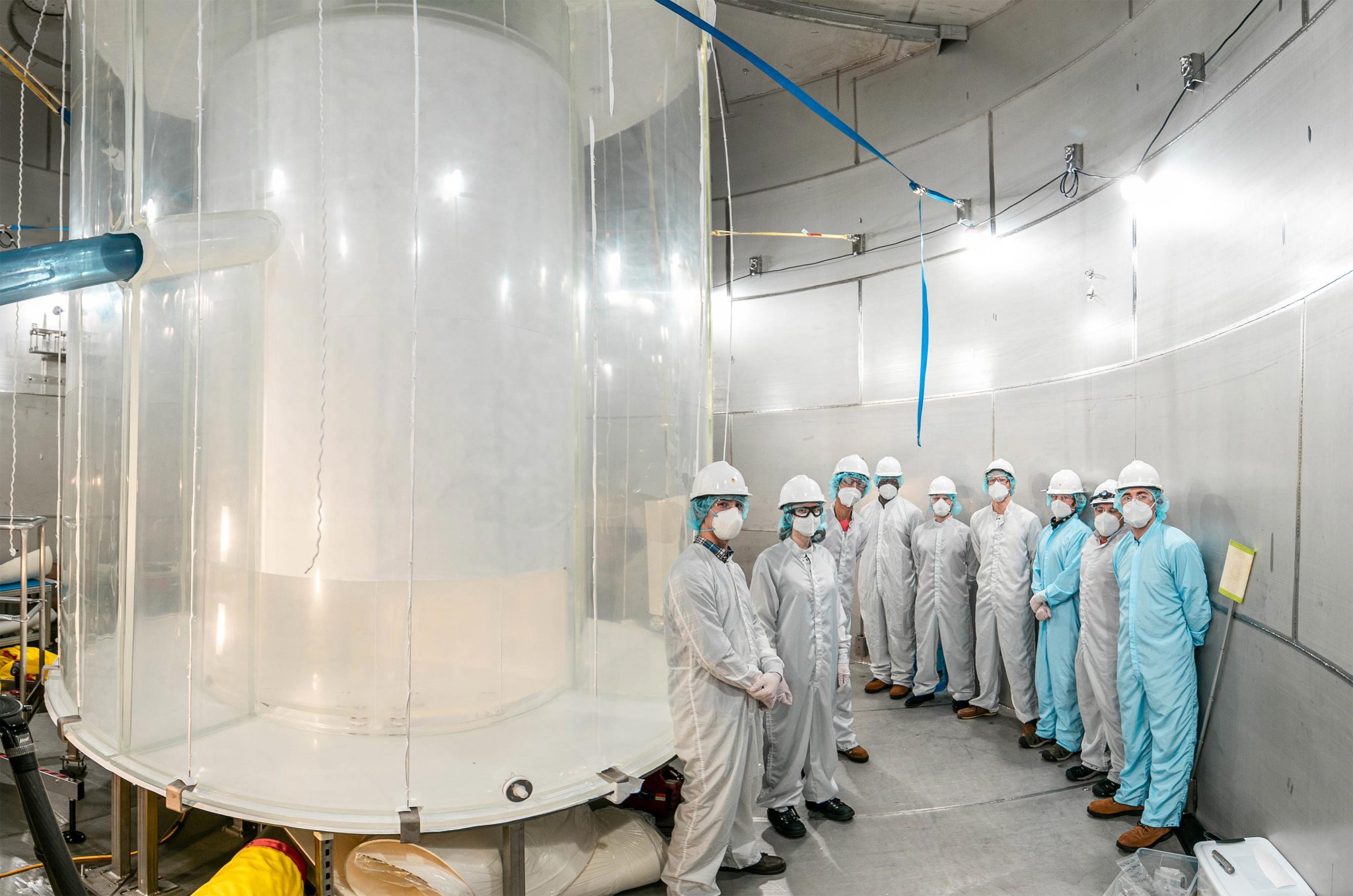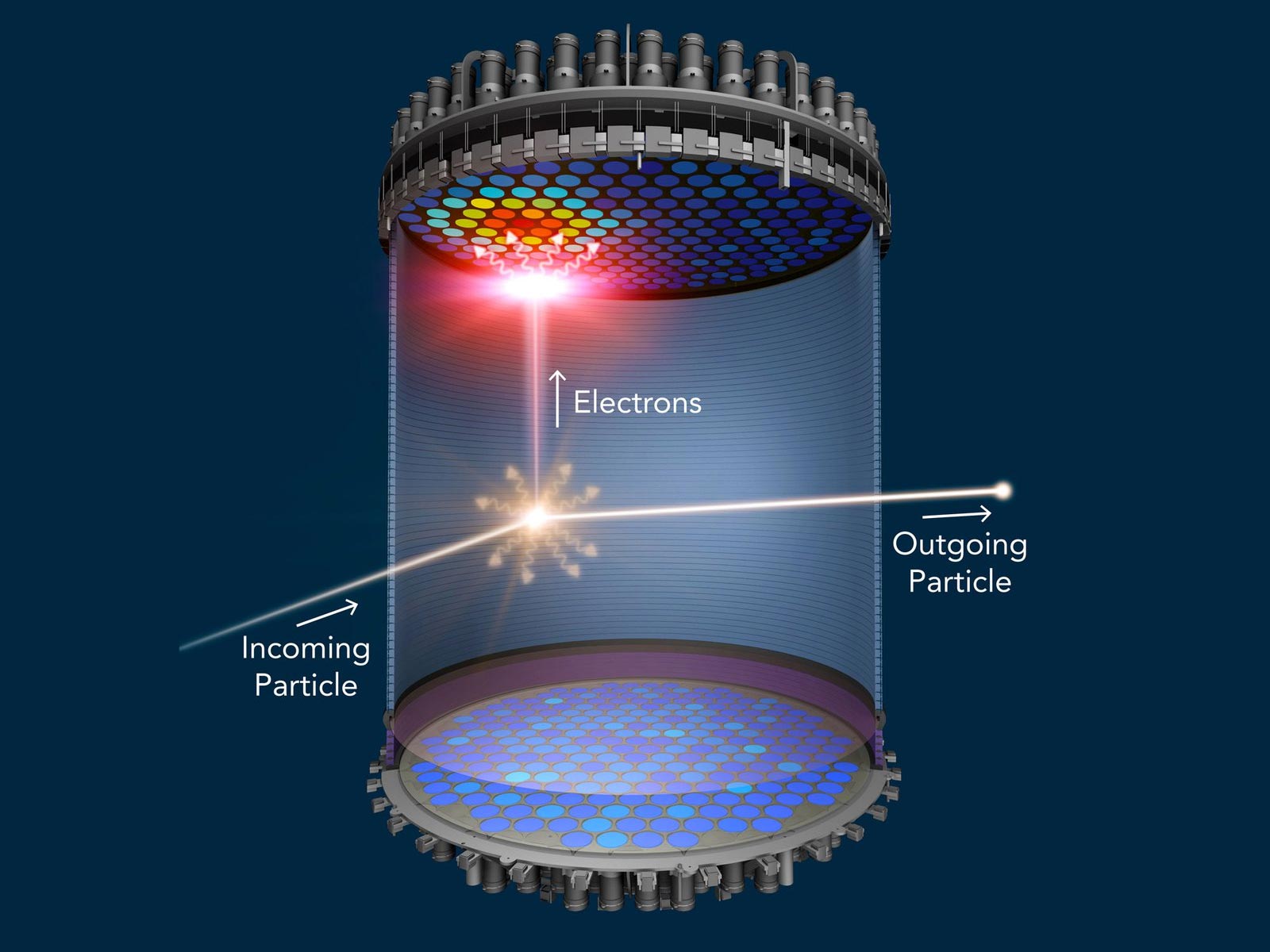
Các thành viên trong đội LZ trong bể chứa nước của bãi đáp sau khi lắp máy dò bên ngoài. Nhà cung cấp hình ảnh: Matthew Capost, Cơ sở Nghiên cứu Ngầm Sanford
Các nhà nghiên cứu của Berkeley Lab ghi lại quá trình khởi động thành công máy dò vật chất tối LUX-ZEPLIN tại Cơ sở Nghiên cứu Ngầm Sanford
Máy dò vật chất tối nhạy cảm và sáng tạo duy nhất Luxe Zeppelin Thử nghiệm (LZ) – Đã vượt qua giai đoạn đăng xuất khởi động và cung cấp kết quả đầu tiên. LZ nằm sâu trong Black Hills của Nam Dakota trong Cơ sở nghiên cứu ngầm Sanford (SURF) và được dẫn đầu bởi Phòng thí nghiệm Quốc gia Lawrence Berkeley của Bộ Năng lượng (Phòng thí nghiệm Berkeley).
“Chúng tôi đã sẵn sàng và mọi thứ có vẻ tốt”, nhà vật lý trưởng Berkeley Lab và cựu phát ngôn viên của LZ, Kevin Lesko, cho biết. Ông nói: “Nó là một máy dò phức tạp với nhiều bộ phận và tất cả chúng đều hoạt động tốt như mong đợi.
Trong một bài báo được xuất bản vào ngày 7 tháng 7 về thử nghiệm trang mạngCác nhà khoa học của LZ báo cáo rằng với hoạt động ban đầu, LZ đã trở thành máy dò vật chất tối nhạy nhất thế giới. Bài báo sẽ xuất hiện trong kho lưu trữ bản in trước trực tuyến arXiv.org vào một ngày sau đó. Người phát ngôn của LZ, Hugh Lippincott của Đại học California, Santa Barbara, cho biết: “Chúng tôi có kế hoạch thu thập lượng dữ liệu nhiều hơn khoảng 20 lần trong những năm tới, vì vậy chúng tôi chỉ mới bắt đầu. ! “

Nghiên cứu Máy dò bên ngoài LZ, được sử dụng để loại bỏ phóng xạ có thể bắt chước tín hiệu vật chất tối. Tín dụng: Matthew Capost / Cơ sở Nghiên cứu Ngầm Sanford
Trong khi vật chất tối Các hạt không thực sự được phát hiện, chúng có thể không còn đúng nữa. Việc đếm ngược có thể đã bắt đầu với kết quả từ 60 ngày thử nghiệm “trực tiếp” đầu tiên cho LZ. Dữ liệu này được thu thập trong ba tháng rưỡi hoạt động ban đầu bắt đầu vào cuối tháng 12. Khoảng thời gian này đủ dài để đảm bảo tất cả các mặt của máy dò hoạt động bình thường.
Mặc dù nó là vô hình, bởi vì nó không phát ra, hấp thụ hay tán xạ ánh sáng, sự tồn tại của vật chất tối và lực hấp dẫn vẫn là nền tảng cơ bản cho sự hiểu biết của chúng ta về vũ trụ. Ví dụ, sự hiện diện của vật chất tối, ước tính chiếm khoảng 85% tổng khối lượng của vũ trụ, định hình hình dạng và chuyển động của các thiên hà, và các nhà nghiên cứu trích dẫn nó để giải thích những gì đã biết về cấu trúc quy mô lớn. và mở rộng vũ trụ.
Hai bể titan lồng nhau chứa đầy 10 tấn xenon lỏng siêu tinh khiết có thể được quan sát bằng hai dãy ống nhân quang (PMT) có khả năng phát hiện các nguồn sáng mờ từ lõi của máy dò vật chất tối LZ. Bể titan được đặt trong một hệ thống máy dò lớn hơn để bắt các hạt có thể bắt chước tín hiệu vật chất tối.
Natalie Palanque Delabruille, Giám đốc Khoa Vật lý tại Phòng thí nghiệm Berkeley cho biết: “Tôi rất vui khi thấy máy dò phức tạp này đã sẵn sàng giải quyết vấn đề lâu nay là vật chất tối được tạo thành từ gì”. “Team LZ hiện có công cụ tham vọng nhất để làm điều này!”
Các giai đoạn thiết kế, sản xuất và lắp đặt máy dò LUX-ZEPLIN do Giám đốc Dự án Phòng thí nghiệm Berkeley Gil Gilchriese kết hợp với đội ngũ 250 nhà khoa học và kỹ sư quốc tế từ hơn 35 tổ chức ở Mỹ, Anh, Bồ Đào Nha và Hàn Quốc. Giám đốc Hoạt động của LZ là Simon Fiorucci của Berkeley Lab. Cùng nhau, họ hy vọng sẽ sử dụng công cụ này để ghi lại bằng chứng trực tiếp đầu tiên về vật chất tối, hay cái gọi là khối lượng còn thiếu trong vũ trụ.
Henrique Araujo, từ[{” attribute=””>Imperial College London, leads the UK groups and previously the last phase of the UK-based ZEPLIN-III program. He worked very closely with the Berkeley team and other colleagues to integrate the international contributions. “We started out with two groups with different outlooks and ended up with a highly tuned orchestra working seamlessly together to deliver a great experiment,” Araújo said.
An underground detector
Tucked away about a mile underground at SURF in Lead, South Dakota, LUX-ZEPLIN is designed to capture dark matter in the form of weakly interacting massive particles (WIMPs). The experiment is underground to protect it from cosmic radiation at the surface that could drown out dark matter signals.
Particle collisions in the xenon produce visible scintillation or flashes of light, which are recorded by the PMTs, explained Aaron Manalaysay from Berkeley Lab who, as physics coordinator, led the collaboration’s efforts to produce these first physics results. “The collaboration worked well together to calibrate and to understand the detector response,” Manalaysay said. “Considering we just turned it on a few months ago and during COVID restrictions, it is impressive we have such significant results already.”

When a WIMP – a hypothetical dark matter particle – collides with a xenon atom, the xenon atom emits a flash of light (gold) and electrons. The flash of light is detected at the top and bottom of the liquid xenon chamber. An electric field pushes the electrons to the top of the chamber, where they generate a second flash of light (red). LZ will be searching for a particular sequence of flashes that cannot be due to anything other than WIMPs. Credit: LZ/SLAC
The collisions will also knock electrons off xenon atoms, sending them to drift to the top of the chamber under an applied electric field where they produce another flash permitting spatial event reconstruction. The characteristics of the scintillation help determine the types of particles interacting in the xenon.
The South Dakota Science and Technology Authority, which manages SURF through a cooperative agreement with the U.S. Department of Energy, secured 80 percent of the xenon in LZ. Funding came from the South Dakota Governor’s office, the South Dakota Community Foundation, the South Dakota State University Foundation, and the University of South Dakota Foundation.
Mike Headley, executive director of SURF Lab, said, “The entire SURF team congratulates the LZ Collaboration in reaching this major milestone. The LZ team has been a wonderful partner and we’re proud to host them at SURF.”

Chemists at Brookhaven Lab used this custom-made vacuum distillation system to purify linear alkyl benzene needed to produce liquid scintillator for the LZ dark matter experiment. Credit: Brookhaven Lab
Fiorucci said the onsite team deserves special praise at this startup milestone, given that the detector was transported underground late in 2019, just before the onset of the COVID-19 pandemic. He said with travel severely restricted, only a few LZ scientists could make the trip to help on site. The team in South Dakota took excellent care of LZ.
“I’d like to second the praise for the team at SURF and would also like to express gratitude to the large number of people who provided remote support throughout the construction, commissioning and operations of LZ, many of whom worked full time from their home institutions making sure the experiment would be a success and continue to do so now,” said Tomasz Biesiadzinski of SLAC, the LZ detector operations manager.
“Lots of subsystems started to come together as we started taking data for detector commissioning, calibrations and science running. Turning on a new experiment is challenging, but we have a great LZ team that worked closely together to get us through the early stages of understanding our detector,” said David Woodward from Pennsylvania State University who coordinates the detector run planning.

The LZ central detector in the clean room at Sanford Underground Research Facility after assembly, before beginning its journey underground. Credit: Matthew Kapust, Sanford Underground Research Facility
Maria Elena Monzani of SLAC, the Deputy Operations Manager for Computing and Software, said “We had amazing scientists and software developers throughout the collaboration, who tirelessly supported data movement, data processing, and simulations, allowing for a flawless commissioning of the detector. The support of NERSC [National Energy Research Scientific Computing Center] Nó là vô giá. “
Lesko cho biết, với xác nhận rằng bãi đáp và các hệ thống của nó đang hoạt động thành công, đã đến lúc bắt đầu quan sát quy mô lớn với hy vọng rằng một hạt vật chất tối va chạm với xenon.[{” attribute=””>atom in the LZ detector very soon.
LZ is supported by the U.S. Department of Energy, Office of Science, Office of High Energy Physics and the National Energy Research Scientific Computing Center, a DOE Office of Science user facility. LZ is also supported by the Science & Technology Facilities Council of the United Kingdom; the Portuguese Foundation for Science and Technology; and the Institute for Basic Science, Korea. Over 35 institutions of higher education and advanced research provided support to LZ. The LZ collaboration acknowledges the assistance of the Sanford Underground Research Facility.
“Nhà phân tích. Con mọt sách thịt xông khói đáng yêu. Doanh nhân. Nhà văn tận tâm. Ninja rượu từng đoạt giải thưởng. Một độc giả quyến rũ một cách tinh tế.”

